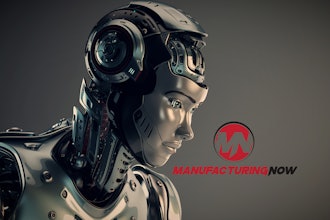Every successful business leader knows that having the right employees on staff, performing the right jobs, is essential to a profitable business. However; not all successful business leaders know that the right person for the job might end up not being a person at all…
Incorporating robotics systems powered by artificial intelligence (AI) into workforces has been a game-changer for many manufacturing companies. Similarly, the supply chain and logistics businesses that adopt these technologies not only find that their warehouses and distribution or fulfillment centers are more productive, but they are more adaptable to business changes and they are able to scale at a much faster pace.
Yet some businesses leaders remain wary of moving to an augmented workforce—a mix of AI-powered robots, collaborative robots, and people—because there is a common misconception that these machines will replace workers. But the truth is, these technologies don’t hurt workers, they can help them. When properly deployed, robotic technologies have the capacity to make supply chain and logistics jobs more engaging and attractive to employees, all while improving employee pay and a company’s bottom line.
Making the Case for an Augmented Workforce
Many companies rely on an augmented workforce to run warehouses and distribution or fulfillment centers. There’s a lot of potential for automation here—U.S. business logistics costs made up 7.7 percent of the nominal GDP in 2017, according to the most recent Annual State of Logistics Report by the Council of Supply Chain Management Professionals. Augmented workforces are better able to optimize processes and dynamically adapt to changing environments than all-human workforces. Businesses grow more flexible, increase productivity, and can accomplish new tasks—all while reducing operational expenses. One more benefit: AI-powered robotics systems allow companies to react nimbly to industry shifts in real time.
Just look at how an augmented workforce has benefited companies all over the world. Robots move pallets and shelving units to help make warehouses more efficient and aid in fulfillment; supply chain management products can pinpoint the optimum route for shipping cargo by processing data on current and historic weather patterns, port congestion, and natural disasters; and anticipatory logistics can give companies an idea of what products will sell and when. Companies as prominent and wide-ranging as Amazon, Gap, and Ocado (a British online supermarket) have all incorporated AI-powered robotics systems so that they can more effectively run warehouses and distribution or fulfillment centers.
Take Nitori, Japan’s largest home-furnishing chain, which expects an effective throughput gain of more than 400 percent in its Osaka fulfillment center after installing AI-powered robotics. Nitori uses an AI-powered platform to drive real-time collaboration with self-navigating autonomous mobile robots (AMRs), which can optimize navigation-path planning, zoning, and speeds. The AMRs are self-learning, so they continually improve and shorten fulfillment times. Nitori can also get valuable insights into product demand, which can be used to predict seasonal trends and product popularity.
How AI-Powered Robotics Systems Benefit Workers
But supply chain businesses aren’t just about the numbers; they’re about the millions of people who work for them too. Today there are fewer applicants for jobs at warehouses and fulfillment or supply-chain centers because the work is repetitive and the training time-consuming. Companies are suffering from a talent shortage and high attrition rates—which increase employee-training costs, delay orders getting to customers on time, decrease order accuracy rates and can lead to a decrease in bottom line profitability.
AI-powered robotics systems can make working at a warehouse and a fulfillment or supply-chain center more attractive because they turn low-paid, menial physical work into better-paid, medium-skilled tech jobs. The talent gap closes, employees are more engaged, and attrition rates lower—sometimes by as much as 50 percent. As an added bonus, training time drops from days to hours because AI-enabled software dynamically adapts to employees.
McKinsey Global Institute’s November 2017 report, Jobs Lost, Jobs Gained: Workforce Transitions in a Time of Automation, found that, although about half of the activities people are currently paid to do could be automated, fewer than 5 percent of occupations consist of activities that could be fully automated. Historically, technological disruptions have brought about large employment and sector shifts—but over time, labor markets adjust, and new jobs are created. In this way, training employees to work with AI-powered robots can help build a more secure future for workers, who will have a leg up on the skills needed to run the warehouses and supply-chain or fulfillment centers of tomorrow.
Implementing AI-Powered Robotics Systems
Larger companies have actually relied on augmented workforces for years. In fact, the demand for high-performance robotics systems is so strong that the robotics segment of the material handling equipment market is expected to reach more than $20 billion by 2024, according to a June 2018 report by Global Marketing Insights. Early adopters have a competitive advantage when it comes to learnings and best practices, but current adopters—companies that deploy AI-powered robotics systems in the next five years—still have the opportunity to leapfrog those sitting on the sidelines if they put plans in motion now.
Consider current adopter XPO Logistics, Inc., a global supply chain solutions company that recently announced plans to deploy 5,000 AMRs in its North American and European logistics sites. These machines are expected to reduce pickers’ walking time by 80 percent and improve picking accuracy by almost 100 percent—increasing standard fulfillment speeds from a manual pick rate of 50-to-80 units per hour to an impressive 200-to-300 units per hour. That’s a dramatic difference.
Here’s a general road map for business interested in augmenting their workforces:
- Identify your desired outcomes. Start with your objectives and work backwards from there. To determine whether or not AI-powered robotics are the right tool to boost your results, examine every step of your current processes with those goals in mind, and ask if AI-powered robotics can help you reach them.
- Find the right partner. Your business may not have the internal resources necessary to develop an augmented workforce. In that case, it may be most cost-effective and time efficient to partner with a company specializing in this field. Look for a partner that can provide solutions which are flexible and can help you cope with various complexities such as seasonal demands.
- Evolve the company culture through education. Employees may worry about the implications of an augmented workforce. Education is key. You may want to point to other companies undergoing a digital transformation, to show how these changes can improve workers lives as well as showcase the new, higher paying, more meaningful types of jobs that will be available once AI-powered robotics is implemented.
With proper implementation, AI-powered robots can help companies boost productivity, minimize inventory waste, increase consumer choice, increase customer service levels and improve the bottom line—all while working hand in hand with humans.
Chris Barber is CEO-North America at GreyOrange.






















